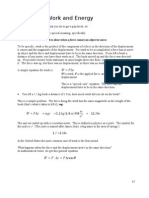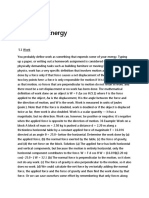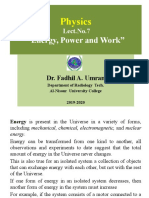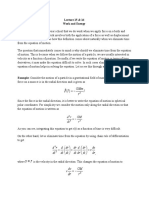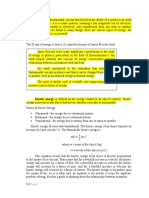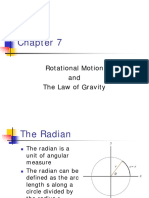Physicscunit 4 Contentreviewsheet
Physicscunit 4 Contentreviewsheet
Uploaded by
mahsan abbasCopyright:
Available Formats
Physicscunit 4 Contentreviewsheet
Physicscunit 4 Contentreviewsheet
Uploaded by
mahsan abbasOriginal Title
Copyright
Available Formats
Share this document
Did you find this document useful?
Is this content inappropriate?
Copyright:
Available Formats
Physicscunit 4 Contentreviewsheet
Physicscunit 4 Contentreviewsheet
Uploaded by
mahsan abbasCopyright:
Available Formats
Unit 4: Energy, Work, Momentum
ENERGY
Objects in mechanics have “mechanical energy” – which can be sorted into kinetic and potential
energies.
- Potential energy is stored energy based on position – an object at a certain height has
gravitational potential energy that can be converted into other forms of energy. It is
denoted with the variable 𝑈 and gravitational potential energy has the formula 𝑈𝐺 = 𝑚𝑔ℎ,
where m is the mass in kilograms, g is the constant 9.8 N/kg, and h is the height that the
object is at in meters (with respect to the reference point).
- Kinetic energy is the energy objects have while in motion. All objects in motion have kinetic
1
energy, and it has the formula 𝐸𝐾 = 2 𝑚𝑣 2 , where mass is again in kilograms and v is the
speed of the object in m/s.
- Kinetic and Potential energy fall under “mechanical energy” whereas thermal energy is
known as internal energy. Conservative forces conserve mechanical energy (e.g. gravity,
energy is conserved when gravity acts on a falling block). Non-conservative forces don’t
conservative mechanical energy (friction, air resistance – energy is still conserved but
becomes heat)
The law of conservation of energy states that the total energy of a system doesn’t change unless an
acted on by an external force.
For example, even when an object slows down by friction, it loses kinetic energy, but gains
thermal energy, and the total energy of the system remains the same.
This concept is what we use to solve problems, like this next one:
Charizard is holding a Pokeball at a height h. He drops it: What is the Pokeball’s speed right before
it hits the floor in terms of the given variables and fundamental constants?
Using our previous knowledge, we could solve the problem with kinematics. But, as you’ll see,
energy is a much easier, more straightforward way to solve this problem.
At the top, before the ball is dropped, it has all 𝑈𝐺 , and right before it hits the floor the ball has all
𝐸𝐾 , and since the total energy didn’t change, we can set them equal to each other: 𝐸𝐾 = 𝑈𝐺 .
1
Therefore, 𝑚𝑔ℎ = 2 𝑚𝑣 2 . Rearranging the equation, the Pokeball’s speed is 𝑣 = √2𝑔ℎ.
ELASTIC FORCE AND POTENTIAL ENERGY
In many problems on the AP exam, you’ll see springs used in problems to add an extra element of
knowledge. Springs are elastics – when compressed or elongated, they want to return to their
original, relaxed state. The force that the string applies on whatever is pulling it is called the
restoring force, or occasionally the spring force.
The formula for spring force is 𝐹𝑆 = −𝑘𝑥, where k is the “spring constant” of the spring, and x is
the distance stretched.
A spring constant measures the spring’s resistance to being stretched (every spring is different). A
spring with a higher spring constant will require more force to stretch the same distance as a spring
Created by Rohin Bhasin and Shreyas Mohan for apphysc.weebly.com
𝐹
with a lower spring constant. Since 𝑘 = 𝑥 , the units for a spring constant are N/m (Newtons per
meter)
The “distance stretched” is the extra distance the spring has compressed or stretched (in meters).
If the spring is 5 cm long, and when stretched is 10 cm long, then the “x” value is 5 cm, or 0.05
meters.
Most of the time, you won’t need the negative in the formula, but that is how it is denoted on the
formula sheet. This shows that the force is always trying to oppose the displacement vector of the
spring. This negative is more important when we get to the Simple Harmonic Motion unit.
One important lab application to determine the spring constant of a spring. The easiest way to do
this is just to orient the spring vertically, then hang a mass from it. After the spring is stable, you
have a known force (gravity) and you can measure the stretched distance, so you can calculate the
spring constant by setting the force of gravity equal to the spring force: 𝐹𝐺 = 𝐹𝑆 , and get the
solution 𝑚𝑔 = 𝑘𝑥.
When a spring is compressed, there is potential energy stored in it. This energy can be transferred
to an object that the spring is contact with. Also, an object can come in contact with the spring
and store energy in it.
If a spring is ideal, that means it can be governed by the F=-kx equation, and that there is no
energy lost when things collide with the spring. The energy stored in a spring (elastic potential
1
energy) can be found with the formula: 𝑈𝑆 = 2 𝑘𝑥 2 . We can use this formula whenever we are
dealing with problems that deal with conservation of energy.
WORK
What is work? Work is, by definition, change in kinetic energy. Whenever an unbalanced external
force is applied on a system, work is done on it.
On the formula sheet, work is written as
Which means it is the integral of force with respect to position (r).
Created by Rohin Bhasin and Shreyas Mohan for apphysc.weebly.com
A quick recall of basic calculus reminds us that an integral is the area under a curve. But, when the
force is constant, we can solve for the area just by doing the force multiplied by the change in
position. Usually, we are dealing with a constant, unbalanced force.
This means that usually we can just do F · d. But, we need to make sure we ONLY use the
component of force that is parallel to the displacement.
To get the component of force that is parallel to the displacement vector, we do Fcos(Θ). If they
are already parallel, the angle is 0, and cosine of 0 is 1.
Our complete formula is then
This is also the scalar product, or dot product of the two vectors F and Δx, in which we care only
about components parallel to each other.
Here’s a basic practice problem with work.
An Ivysaur is pulled right with a tension force of 15 N, and a frictional force of 5 N opposes the
motion. The box is displaced 2.5 m from its starting position. What is the work done by each force,
and what is the net work on the object?
Solution: The tension force is in the same direction as the displacement, so we do 15𝑁 ∗ 2.5𝑚 ∗
cos(0) = 37.5 𝐽
The frictional force is in the opposite direction as the displacement, so we do 5𝑁 ∗ 2.5𝑚 ∗
cos(180) = −12.5𝐽
NOTE that if the force and displacement are in opposite directions, the force is doing negative
work on the object. The net work can be calculated by adding these works together, resulting in
25J. Alternatively we could calculate the net force (10N) and do 10𝑁 ∗ 2.5𝑚 ∗ cos(0) = 25 𝐽.
Here’s another practice problem:
Joe holds a 50 kg Dragonite at a height of 1.5 m for 2 minutes. What is the work done by his
applied force?
Created by Rohin Bhasin and Shreyas Mohan for apphysc.weebly.com
Solution: NO WORK IS DONE! There is no displacement at all in the direction of the applied force –
Joe may be getting super tired, but he’s actually doing no work. If displacement is 0, then work is
0!
WORK-ENERGY EQUIVALENCE
One of the most important formulas is Work = ΔKE. Work equals change in kinetic energy, and thus
also equals the negative change in potential energy.
For example: If we drop a 2kg ball from a height of 10 meters, the work done by gravity is 𝑊 =
𝑁
𝐹𝑑 = (2𝑘𝑔) (9.8 𝑘𝑔) (10 𝑚) = 196 𝐽. The change in potential energy is ∆𝑈 = 𝑚𝑔ℎ𝑓 − 𝑚𝑔ℎ𝑖 = −196 𝐽.
From this example, we can see that 𝑊 = −∆𝑈 = ∆𝐾𝐸
𝑑𝑈
Another formula that comes as a result of this is 𝐹 = − 𝑑𝑥 , Force is the negative derivative of
potential energy with respect to position. If force is constant, then the change in potential energy
is also constant. This is mostly applied mathematically on the AP exam.
POWER
Power is known as the rate of energy transfer, and can be solved as the amount of work W done
𝑊
over a time interval t. Thus, the formula is 𝑃 = 𝑡 , and it is measured in Watts (J/s). Power can also
be calculated as 𝑃 = 𝐹𝑣, when the object is moving at a constant velocity pushed by a constant
force.
If the power is changing (Work is changing non-linearly with respect to time) then instantaneous
𝑑𝑊
power can be found with 𝑃 = .
𝑑𝑡
MOMENTUM
Momentum is a measure of how difficult it is to stop a moving object. The formula for momentum
is 𝑝 = 𝑚𝑣, and it is measured in kg*m/s.
The law of conservation of momentum states that, if no external force is applied on the
system, the sum of all individual momenta will be the same before and after a collision.
Objects in motion also have kinetic energy, but kinetic energy is not conserved in collisions.
Although, if a collision is specified as elastic, then kinetic energy is indeed conserved.
In inelastic collisions (which are most collisions in the world) momentum is conserved, but kinetic
energy is lost to thermal energy, meaning mechanical energy is not conserved.
Conservation of momentum can be demonstrated in a variety of ways:
Created by Rohin Bhasin and Shreyas Mohan for apphysc.weebly.com
The first situation is when there is no collision in the dimension of motion of the original object.
This will be elaborated on later, but for now all you need to know is that the object’s mass could
change, leading its velocity to change as well because the momentum is conserved.
The second situation (top left) is when two objects collide and stick together to become one more
massive object.
The third situation (bottom right) is when one object breaks up into two objects (usually in
opposite directions) and momentum is conserved.
The fourth situation is when two objects collide and remain separate, either having directional
changes, mass changes, or speed changes.
There are obviously other situations, but these are the common ways that conservation of
momentum is used in solving problems. Let’s look at a sample:
Problem: Sally (38 kg) and Phillip (43 kg) are on an ice rink, and can slide freely. Sally is holding a
5 kg pumpkin. Sally tosses the pumpkin with a speed of 5 m/s to Phillip, who is initially moving at
10 m/s in the same direction as the pumpkin. What is a) Sally’s velocity after throwing the
pumpkin? And b) Phillip’s velocity after catching the pumpkin?
Solution: Firstly, we know they are on ice skates, so there is no friction and they can move freely.
So, first solving part a, we know that initially Sally and the pumpkin have a cumulative mass of 43
kg, and are stationary (0 m/s). Afterwards, the pumpkin is moving away from Sally at 5 m/s. Thus,
we can form the following conservation of momentum equation.
0𝑚 𝑚
(43 𝑘𝑔) ( ) = (38 𝑘𝑔)(𝑣1 ) + (5 𝑘𝑔)(5 )
𝑠 𝑠
Since there was 0 total momentum before, there must be 0 total momentum after:
𝑚
−(38 𝑘𝑔)(𝑣1 ) = 25 𝑘𝑔
𝑠
𝑣1 = −0.66 𝑚/𝑠
This means that Sally is moving backward at 0.66 m/s, which is what we’d expect: a slow speed
rebounding away from the direction she threw the pumpkin (this is the same reason guns have
recoil when bullets are fired).
As for Phillip, he already has a speed before, and the two objects (him and the Pumpkin) become
one object. So we can write his conservation of momentum equation like so:
𝑚 𝑚
(43 𝑘𝑔) (10 ) + (5 𝑘𝑔) (5 ) = (48 𝑘𝑔)(𝑣3 )
𝑠 𝑠
𝑚
455 𝑘𝑔 = (48 𝑘𝑔)(𝑣3 )
𝑠
𝑣3 = 9.48 𝑚/𝑠
Since his mass increased slightly, he has slowed down slightly as well. This is an expected result.
Created by Rohin Bhasin and Shreyas Mohan for apphysc.weebly.com
MOMENTUM IN 2D
Things aren’t always moving in straight lines, though. We must also deal with objects moving in
two dimensions. When something is moving in both dimensions, we must divide the momentum up
into x and y dimensions, and make sure each dimension is conserved after a collision. There won’t
be an example for this, but there will be one like this on the worksheet with a solution as well.
IMPULSE
Momentum is always conserved if there are no external forces on the system. But what if there
were internal forces? Then the object or system has an impulse applied on it. Impulse, put simply is
a change in momentum. It can also be expressed as the area under a force time graph. If the force
is constant, the graph looks like:
In this case, Force multiplied by time gives us the area under the graph, giving us the general
equation for impulse: 𝐼 = ∆𝑝 = 𝐹𝑡, where force is the constant force acting on an object and the
time is the time that it acts on the object for. This is usually just a plug and chug in AP problems,
but it is also important to know that the impulse vector points the same direction as the force
vector.
COMBINING ENERGY AND MOMENTUM
For many problems you’ll have to use energy and momentum together. For example, if something
slides down a frictionless ramp and then collides with a different cart, we can use energy for the
first half of the problem, solve for the velocity of the object, then use momentum for the collision
part. These problem solving strategies are essential for success on the free response section of the
AP test, and will be practiced in the worksheets.
Created by Rohin Bhasin and Shreyas Mohan for apphysc.weebly.com
You might also like
- Forces: AQA 2016 Physics Topic 5Document104 pagesForces: AQA 2016 Physics Topic 5mahsan abbasNo ratings yet
- Unit 1 of The Grade 8 Integrated Science Deals With ForceDocument4 pagesUnit 1 of The Grade 8 Integrated Science Deals With ForceNorvie Magdato RuelNo ratings yet
- 03 - Fundamentals of Physics - Naghi GasimovDocument25 pages03 - Fundamentals of Physics - Naghi GasimovKVP LyricsNo ratings yet
- Work, Power & EnergyDocument16 pagesWork, Power & EnergyAyush GamerNo ratings yet
- 08 Work and EnergyDocument13 pages08 Work and Energyapi-27085921No ratings yet
- NoessDocument7 pagesNoessarpita9619080670No ratings yet
- MechanicsDocument7 pagesMechanicsblademasters253No ratings yet
- LECTURE in PHysicSDocument13 pagesLECTURE in PHysicSKenji BaguaNo ratings yet
- Physics Grade 9 SummaryDocument12 pagesPhysics Grade 9 Summaryvaneliana5387No ratings yet
- 4-1 - Work and EnergyDocument11 pages4-1 - Work and Energycarlos51952No ratings yet
- Newtons Laws of Motion 24Document13 pagesNewtons Laws of Motion 24jimmymungai018No ratings yet
- Potential E., Mechanical E.Document5 pagesPotential E., Mechanical E.Doctora NourhanNo ratings yet
- CH-6 Work, Energy and PowerDocument31 pagesCH-6 Work, Energy and PowerSurendra singhNo ratings yet
- Work Energy Power 24Document10 pagesWork Energy Power 24Siddharth VarriNo ratings yet
- General Physics Chapter 5 NotesDocument7 pagesGeneral Physics Chapter 5 NotesKate Abegail BacoNo ratings yet
- Lab 4: Work and EnergyDocument8 pagesLab 4: Work and EnergyWaseem Al-khawajaNo ratings yet
- Work EnergyDocument48 pagesWork EnergyawesomelyaliNo ratings yet
- Work Energy and PowerDocument5 pagesWork Energy and PowerjunquelalaNo ratings yet
- Chapter 6 - Work and EnergyDocument5 pagesChapter 6 - Work and EnergyDatu Sarip Azeemkhan Ampatuan-BernanNo ratings yet
- Mechanical Energy Class 11 ProjectDocument11 pagesMechanical Energy Class 11 ProjectAnkita Kumari67% (3)
- Lect. 7, Energy, Power, and WorkDocument22 pagesLect. 7, Energy, Power, and WorkNawras aliNo ratings yet
- EnergyDocument36 pagesEnergyyuxing lieNo ratings yet
- General Physics 1Document31 pagesGeneral Physics 1Ali aliraqiNo ratings yet
- Phy 311 Unit 2 - Chap 16-17Document25 pagesPhy 311 Unit 2 - Chap 16-17Alex William JohnNo ratings yet
- Lecture 15 & 16 Work and EnergyDocument12 pagesLecture 15 & 16 Work and Energyrizal123No ratings yet
- Chapter 6 Physics 1Document4 pagesChapter 6 Physics 1pjg20No ratings yet
- Work, Power and EnergyDocument4 pagesWork, Power and EnergyJeya Plays YTNo ratings yet
- Physics For Future Presidents LectureDocument41 pagesPhysics For Future Presidents LectureJohn CrawfordNo ratings yet
- JN1.P05.RS MridulaDocument20 pagesJN1.P05.RS MridulajainNo ratings yet
- Week 5Document54 pagesWeek 5christinereponte160No ratings yet
- StaticsDocument6 pagesStaticsWednesday GuillermoNo ratings yet
- Work, Kinetic, Potential and Total Energy: Dr. Mahabub Alam Bhuiyan Associate Professor of PhysicsDocument44 pagesWork, Kinetic, Potential and Total Energy: Dr. Mahabub Alam Bhuiyan Associate Professor of Physicsaxe.dos.xdaNo ratings yet
- Affiliated To Central Board of Secondary Education - New DelhiDocument4 pagesAffiliated To Central Board of Secondary Education - New Delhideetchu10No ratings yet
- Force, Motion & EnergyDocument10 pagesForce, Motion & EnergyShelin GaziNo ratings yet
- CH 7 EnergyDocument73 pagesCH 7 Energyp837No ratings yet
- Work, Energy and Power: Art Intgrated ActivityDocument27 pagesWork, Energy and Power: Art Intgrated ActivitylakeishaNo ratings yet
- Work and EnergyDocument28 pagesWork and EnergythepixelateanimatorNo ratings yet
- Work Power & EnergyDocument34 pagesWork Power & EnergyRamya PrabakaranNo ratings yet
- Work and Kinetic EnergyDocument3 pagesWork and Kinetic EnergyDEEPAK TNo ratings yet
- EnergyDocument6 pagesEnergyChristina LuluquisinNo ratings yet
- Kinetic Energy and WorkDocument15 pagesKinetic Energy and WorkMahesh KumarNo ratings yet
- Work Energy and PowerDocument20 pagesWork Energy and PowerFayez AhmedNo ratings yet
- Work, Energy and PowerDocument5 pagesWork, Energy and PowerT.P BHARATHNo ratings yet
- AP Physics B Exam Cram Sheet (Ver. 5.01) General Reminders: X X y y ResultantDocument8 pagesAP Physics B Exam Cram Sheet (Ver. 5.01) General Reminders: X X y y Resultantkirsten hutchNo ratings yet
- Module 2. Work, Energy, and Conservation of EnergyDocument95 pagesModule 2. Work, Energy, and Conservation of Energytiredstudent03No ratings yet
- Physics 6 PDFDocument12 pagesPhysics 6 PDFShivani Shree SundaramoorthyNo ratings yet
- UPSC CAPF: Physics - Notes - Work - Power - Energy - 54Document4 pagesUPSC CAPF: Physics - Notes - Work - Power - Energy - 54Phani GopalNo ratings yet
- Potential EnergyDocument5 pagesPotential EnergyRhealyn AlamaNo ratings yet
- Ap Lab 2 docx (2)Document12 pagesAp Lab 2 docx (2)Abdul SalamNo ratings yet
- Work Energy and PowerDocument42 pagesWork Energy and PowerKryschan CaditeNo ratings yet
- PetrologyDocument5 pagesPetrologynorikivesNo ratings yet
- Chapter 11 - Work and Energy Revision Notes PDFDocument8 pagesChapter 11 - Work and Energy Revision Notes PDFShuchi MaheshwariNo ratings yet
- Work and Energy CW NotesDocument4 pagesWork and Energy CW Notesananyaa171010No ratings yet
- CH 14Document33 pagesCH 14Abdallah OdeibatNo ratings yet
- Energy and PowerDocument23 pagesEnergy and Powershreyasharma23858No ratings yet
- DSAE_PHY109_lecture_4Document18 pagesDSAE_PHY109_lecture_4hasibhossain22441No ratings yet
- PHY101 Lecture Note 6Document13 pagesPHY101 Lecture Note 6Justus praise AyomideNo ratings yet
- Work Energy and PowerDocument9 pagesWork Energy and PowerchilalaloudsNo ratings yet
- Work, Energy, and PowerDocument15 pagesWork, Energy, and PowerperwinsharmaNo ratings yet
- Power, Momentum and Collisions - Physics for Kids - 5th Grade | Children's Physics BooksFrom EverandPower, Momentum and Collisions - Physics for Kids - 5th Grade | Children's Physics BooksNo ratings yet
- hssp0100t Teachvis11Document1 pagehssp0100t Teachvis11mahsan abbasNo ratings yet
- hssp0100t SecstudygdDocument4 pageshssp0100t Secstudygdmahsan abbasNo ratings yet
- Magnetism and EM Induction - PAP 2Document26 pagesMagnetism and EM Induction - PAP 2mahsan abbasNo ratings yet
- AP Physics I KinematicsDocument5 pagesAP Physics I Kinematicsmahsan abbasNo ratings yet
- Ap22 FRQ Physics C Mechanics Set 1Document17 pagesAp22 FRQ Physics C Mechanics Set 1mahsan abbasNo ratings yet
- 04 SolvingEquationswithVariableonEachSide ADDocument48 pages04 SolvingEquationswithVariableonEachSide ADmahsan abbasNo ratings yet
- Rotational Motion and The Law of GravityDocument47 pagesRotational Motion and The Law of Gravitymahsan abbasNo ratings yet
- Rotational Equilibrium and Rotational DynamicsDocument49 pagesRotational Equilibrium and Rotational Dynamicsmahsan abbasNo ratings yet
- 11ap 1Document7 pages11ap 1mahsan abbasNo ratings yet
- 03 Transfer of HeatDocument34 pages03 Transfer of Heatmahsan abbasNo ratings yet
- 1 Forces and Motion C2b Part II - Moments & Newtons 3rd: iGCSE Edexcel 1-9 - MR PowellDocument42 pages1 Forces and Motion C2b Part II - Moments & Newtons 3rd: iGCSE Edexcel 1-9 - MR Powellmahsan abbasNo ratings yet
- 1 Forces and Motion - Units A: iGCSE Edexcel 1-9 - MR PowellDocument5 pages1 Forces and Motion - Units A: iGCSE Edexcel 1-9 - MR Powellmahsan abbasNo ratings yet
- PHYSICS-23-07 - 11th (J-Batch) SOLUTIONDocument3 pagesPHYSICS-23-07 - 11th (J-Batch) SOLUTIONRaju SinghNo ratings yet
- PAPERDocument20 pagesPAPERAakash MehtaNo ratings yet
- Total SSC Physics 2015Document51 pagesTotal SSC Physics 2015Abdullah Al Mamun50% (2)
- 13-08-22 JR - Super60 (Incoming) Jee-Main WTM-09 Q.paperDocument18 pages13-08-22 JR - Super60 (Incoming) Jee-Main WTM-09 Q.paperAjitesh Gupta GudisaNo ratings yet
- Y20 Phy102 EsDocument28 pagesY20 Phy102 EsSAURAV kumarNo ratings yet
- SG_PracticeFRQ345_67509399992b85.6750939cd77c73.85923485Document26 pagesSG_PracticeFRQ345_67509399992b85.6750939cd77c73.85923485satyank.kanugula.11No ratings yet
- Basic Engineering Science - A Systems Accounting and ModelingDocument525 pagesBasic Engineering Science - A Systems Accounting and ModelingAlex KahuraNo ratings yet
- Science8 q1 Mod3 Potential-And-kinetic-EnergyDocument20 pagesScience8 q1 Mod3 Potential-And-kinetic-EnergyJarred LazoNo ratings yet
- Forces QBDocument156 pagesForces QBPrisha GargNo ratings yet
- Lecture Notes # 5: Dynamics of Rigid BodiesDocument13 pagesLecture Notes # 5: Dynamics of Rigid BodiesmymeeepNo ratings yet
- Pre-Test: Guidance MaterialDocument29 pagesPre-Test: Guidance MaterialshambelNo ratings yet
- Engineering Mechanics - Dynamics - 9780495295617 - Exercise 19 - QuizletDocument5 pagesEngineering Mechanics - Dynamics - 9780495295617 - Exercise 19 - QuizletAmirali SahebzamaniNo ratings yet
- Energy Is The Capacity of Matter To Perform Work As The ResultDocument2 pagesEnergy Is The Capacity of Matter To Perform Work As The ResultJhune Dominique GalangNo ratings yet
- Probset 29 NovDocument2 pagesProbset 29 Novjamesdlcrz07No ratings yet
- Work, Power and EnergyDocument22 pagesWork, Power and EnergyFrancis FrimpongNo ratings yet
- Test Planner - Arjuna NEET 2024Document1 pageTest Planner - Arjuna NEET 2024An CNo ratings yet
- 7 PDFDocument103 pages7 PDFmuhammad izzulNo ratings yet
- GGPS Syllabus 11Document42 pagesGGPS Syllabus 11tajbgpNo ratings yet
- Final Terminal Practice Question 2024 MCQDocument12 pagesFinal Terminal Practice Question 2024 MCQrifahnnira27No ratings yet
- Class 11 PhysicsDocument3 pagesClass 11 PhysicsMask Man LifeNo ratings yet
- A Level Work Energy PowerDocument17 pagesA Level Work Energy PowerHuurun AinNo ratings yet
- Cambridge IGCSE: Physics 0625/22Document16 pagesCambridge IGCSE: Physics 0625/22yuNo ratings yet
- Competencies ScienceDocument80 pagesCompetencies ScienceRosalyn Angcay QuintinitaNo ratings yet
- Momentum SolutionsDocument10 pagesMomentum Solutionsminglei caiNo ratings yet
- PowerDocument20 pagesPowerErl John OctavianoNo ratings yet
- The Ultimate IGCSE Physics GuideDocument40 pagesThe Ultimate IGCSE Physics GuideRebecca Sarah Jaya-Sudhir100% (3)
- Organic Compound Lesson Plan2Document10 pagesOrganic Compound Lesson Plan2marizel ortegaNo ratings yet
- 11 Vol 1 and 2 Important Questions EM PDFDocument5 pages11 Vol 1 and 2 Important Questions EM PDFvvn natrajNo ratings yet
- CLASSDocument239 pagesCLASSVaibhav jiNo ratings yet
- CM Chap 2 Lecture Notes PDFDocument24 pagesCM Chap 2 Lecture Notes PDFMin ZawshinnNo ratings yet









